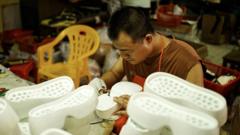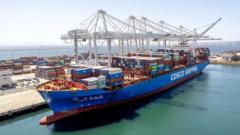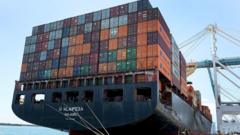The ongoing trade war has brought significant challenges to small Chinese enterprises, with many reporting halted production and excess inventory due to high tariffs imposed by the US. Tariff impacts are not just felt domestically; they could influence consumer prices and economic stability in the US as well.**
Small Chinese Businesses Face Crisis as Tariffs Persist Amid Trade War**

Small Chinese Businesses Face Crisis as Tariffs Persist Amid Trade War**
Many small businesses in China are struggling as US tariffs persist, significantly affecting their exports and survival.**
The economic landscape in China remains troubling for small businesses as they grapple with overwhelming tariffs placed by the United States. On the ground in Guangzhou, many entrepreneurs express deep concern, voicing their frustrations about the current climate. Lionel Xu, the owner of a mosquito repellent company, captures the sentiment succinctly: “This is so hard for us.” A significant portion of his production, nearly half, caters to the US market, and the imposition of a 145% tariff has left his products gathering dust in warehouses instead of reaching American consumers.
Xu’s sentiments resonate throughout the Canton Fair, where vendors like Amy from Guangdong Sailing Trade Company are detouring into new production pathways. “We have stopped production already,” she shares, echoing the halt felt across various sectors. With US buyers increasingly hesitant due to the enhanced costs, these businesses face an uncertain future.
The trade war, which has seen both the US and China implement retaliatory tariffs, has left countless entrepreneurs bewildered. While President Trump has temporarily paused many tariffs amid international economic turbulence, the heavy taxes on Chinese goods remain. This dual-layered tariff approach creates a gridlock affecting over 30,000 vendors at the Fair, leaving many scrambling to redirect their export strategies toward less traditional markets such as Europe and Saudi Arabia.
While Chinese policy makers emphasize cultivating a robust internal market, consumer behavior has shifted sharply due to previous investments in real estate combined with recent economic fluctuations. Current expenditure is tumbling, leaving many citizens reluctant to spend after navigating price drops in housing.
As Chinese manufacturing faces its most significant challenge, workers in factories report distressing declines in earnings as demand dwindles. A factory worker lamented his current earnings of 100 yuan daily, down from 300-400 yuan previously, revealing the undercurrents of desperation flowing through the workforce.
This economic disruption underscores the fragility of global trade links, as both nations stand firm, waiting for the other to yield. The possibility of a prolonged standoff looms large, as recent communications between the US and Chinese governments remain sparse. While some companies at the Canton Fair seek alternative markets, uncertainty persists around when — or if — a resolution will be found, leaving both economies at a crucial juncture.






















